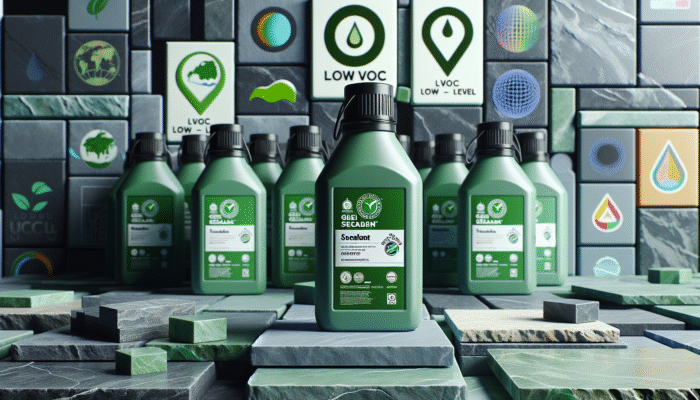Unlock the Full Potential of Your Home with Eco-Friendly Sealants for Stone Tiles
Discover the Unique Benefits of Eco-Friendly Sealants

The concept of sustainability has surged in importance within the fields of construction and home improvement. Eco-friendly sealants for stone tiles are specifically designed to minimise negative impacts on both our environment and public health. Unlike traditional sealants that frequently contain harmful volatile organic compounds (VOCs) and other toxic substances, eco-friendly alternatives primarily consist of non-toxic and biodegradable ingredients. This characteristic ensures that once their functional lifespan concludes, they break down safely, thus preventing the release of hazardous chemicals into our environment.
When selecting a sealant, it is vital to comprehend the manufacturing processes involved. Eco-friendly sealants focus on minimising environmental impact by predominantly utilising renewable materials and sustainable production methods. In the UK, products endorsed by reputable certifications provide consumers with assurance regarding their eco-friendly claims. These certifications indicate compliance with rigorous environmental standards, allowing informed purchasing decisions that resonate with ecological values.
Moreover, the application of eco-friendly sealants for stone tiles significantly improves indoor air quality. By dramatically reducing the emission of toxic substances, these sealants create a healthier living environment, which is particularly beneficial for individuals with allergies or respiratory conditions. This aspect renders them an exceptional choice for households dedicated to fostering safer living spaces.
Uncovering the Key Benefits of Eco-Friendly Sealants
Choosing eco-friendly sealants for stone tiles transcends mere aesthetic enhancement; it substantially prolongs the lifespan and durability of stone surfaces. These sealants create a robust protective barrier against stains, moisture, and environmental wear, a particularly advantageous feature in the UK's unpredictable weather conditions. The natural ingredients found in eco-friendly formulations typically enable these sealants to be breathable, allowing for the evaporation of trapped moisture within the stone, thereby preventing potential damage.
Additionally, the use of non-toxic ingredients ensures heightened safety during and after the application process. Homeowners can rest assured that the products they are employing do not emit harmful vapours, an essential factor for families with children and pets, where chemical exposure raises legitimate concerns. The long-term advantages are equally significant; investing in eco-friendly sealants can significantly reduce the likelihood of costly repairs and replacements that may arise from inadequate sealing.
Furthermore, selecting eco-friendly sealants for stone tiles aligns with broader environmental initiatives. By opting for sustainable products, consumers actively participate in diminishing the overall carbon footprint related to traditional sealants, which often impose a heavier environmental burden during both their production and disposal phases.
Understanding the Key Ingredients in Eco-Friendly Sealants
Gaining insight into the components that constitute eco-friendly sealants for stone tiles is essential for making informed purchasing decisions. Typically, these sealants are composed of natural waxes, plant oils, and water-based polymers. Natural waxes, such as carnauba and beeswax, deliver water-repellent capabilities while remaining environmentally friendly. These waxes establish a protective layer over the stone, enhancing its aesthetic appeal while shielding it from moisture infiltration.
Plant oils derived from sources like soy or linseed are another prevalent ingredient. These oils effectively seal stone surfaces while providing a natural finish that homeowners frequently desire. Their clarity allows for the enhancement of the stone’s inherent colours and patterns without obscuring them, thus preserving the natural beauty of the stone.
Water-based polymers, in contrast to solvent-based alternatives, are crucial in making the sealant easy to apply and clean up. These polymers generally exhibit lower VOC levels, making them more eco-friendly and safer for indoor applications. Familiarity with these ingredients empowers consumers to select products that not only fulfill their sealing requirements but also align with their commitment to environmental sustainability.
Expert Insights for Choosing the Perfect Eco-Friendly Sealant

Selecting the ideal eco-friendly sealants for stone tiles requires careful consideration to ensure optimal performance and safety. A key factor to evaluate is the sealant’s VOC levels; lower levels indicate a reduced environmental impact and lower health risks. Products with a VOC rating below 50 g/L are generally deemed safe for indoor use.
Certification labels can further assist consumers in making responsible choices. Look for products certified by organisations such as Green Seal or EcoLabel, as these endorsements confirm that the sealant meets strict environmental criteria. Additionally, ensuring compatibility with the specific type of stone tile is crucial; not all sealants perform equally across different stone types. For example, <a href="https://limitsofstrategy.com/sealers-for-limestone-floors-essential-tips-for-uk-homeowners/">limestone</a> may require a breathable sealant to facilitate moisture exchange, while more resilient options might be necessary for slate or granite.
Another important consideration is the intended application area. Whether for indoor flooring, outdoor patios, or commercial spaces, understanding the sealant’s performance characteristics in diverse conditions will yield more satisfactory outcomes. Finally, consult product reviews and seek recommendations from local suppliers to ensure you are making the best choice tailored to your specific circumstances.
Delving into the Varied Selection of Stone Tiles Available in the UK
Top Choices for Stone Tiles in UK Homes
The diverse landscape of the UK is reflected in the wide range of stone tiles available for residential applications. Among the most popular choices are limestone, slate, and sandstone, each offering distinct features and aesthetic appeal.
Limestone, renowned for its natural beauty and warmth, is a common choice in many homes. It comes in an array of colours and textures, rendering it versatile for both traditional and modern designs. Its porous nature necessitates appropriate sealing to prevent stains and moisture damage, highlighting the importance of selecting a suitable eco-friendly sealant for stone tiles to maintain its charm.
In contrast, slate is celebrated for its durability and wear resistance. With its rich hues and layered appearance, it provides a striking visual impact, making it a preferred choice for both indoor and outdoor installations. Due to its density, slate generally benefits from more robust sealants that can withstand the elements, particularly in outdoor environments where weather conditions can vary significantly.
Sandstone, characterised by its earthy tones and textured surface, adds a rustic charm to any setting. Commonly used in patios and garden pathways, it also requires effective sealing to combat the effects of weathering and staining. Considering the specific requirements of each stone type when choosing eco-friendly sealants for stone tiles ensures that homeowners can enjoy both beauty and durability in their flooring choices.
Selecting the Right Sealants for Various Stone Types

When sealing stone tiles, it is crucial to recognise that not all sealants are created equal. Different stone varieties require specific sealants tailored to their unique characteristics. For limestone, breathable sealants are essential to allow moisture trapped within the stone to escape, preventing issues such as efflorescence, which can damage the tile over time. An effective eco-friendly option for limestone could include a natural wax or a water-based sealant designed to enhance breathability.
Conversely, the dense structure of slate permits it to endure more robust treatments. Durable, water-repellent sealants are ideal for slate tiles, offering strong protection against stains and wear while preserving the slate’s natural beauty. Such sealants typically incorporate more potent polymers that bond effectively with the stone surface, ensuring long-lasting durability.
Sandstone, being inherently porous, necessitates a sealant that balances protection and breathability. An ideal solution would be a hybrid sealant that offers water resistance while still allowing the stone to breathe. This approach not only enhances the longevity of sandstone tiles but also aids in maintaining their aesthetic appeal.
Selecting the appropriate sealants for each stone type involves understanding their specific needs and the environmental conditions they will face. Homeowners should seek expert advice at local tile shops or consult product specifications to pinpoint the most suitable eco-friendly options for their stone tiles.
Where to Purchase Stone Tiles in the UK
In the UK, homeowners have a plethora of options for sourcing stone tiles. Major cities like London, Manchester, and Edinburgh feature numerous specialist tile shops that offer a wide selection of stone tiles, ranging from classic limestone to contemporary slate. These retailers often provide the added advantage of knowledgeable staff who can assist customers in selecting the right tiles and accompanying products, including eco-friendly sealants for stone tiles.
Online retailers also offer a convenient option, with many featuring comprehensive catalogues that cater to various preferences and budgets. Shopping online simplifies price comparisons and product specifications, streamlining the process of discovering the best deals. However, ensuring that the retailer is reputable is vital to guarantee the quality of the stone tiles purchased.
Local builders’ merchants frequently stock a selection of stone tiles as well, providing convenience for those engaged in renovations or new constructions. These merchants often carry various brands, including eco-friendly options, facilitating a seamless shopping experience for all associated building materials.
For individuals in search of unique or reclaimed stone tiles, specialised suppliers present an excellent alternative. These retailers typically offer a variety of antique or bespoke stone tiles that can add character and individuality to any home. Exploring these options not only enhances aesthetic appeal but also supports sustainable practices through the reuse of materials.
Vital Maintenance Tips for Stone Tiles
Proper maintenance of stone tiles is essential for preserving their beauty and extending their lifespan. Regular cleaning is the foundational step towards maintaining the integrity of both the tiles and any eco-friendly sealants for stone tiles applied. Homeowners should opt for pH-neutral cleaners that are safe for both the stone and the sealant. Avoiding harsh chemicals is crucial, as they can strip protective layers and cause discolouration or surface damage.
In addition to cleaning, regular sealing is essential to protect stone tiles from stains and moisture damage. Depending on the type of stone and the specific sealant used, homeowners may need to reseal their tiles every one to two years. Monitoring the surface for signs of wear, such as water no longer beading on the surface, can help determine when resealing is necessary.
Selecting the right tools for cleaning also plays a pivotal role in maintaining the condition of stone tiles. Soft cloths or mops are recommended to avoid scratching, while abrasive scrubbers should be avoided to protect the surface. For outdoor tiles, regular sweeping and occasional hosing down can help eliminate debris and prevent mould or algae growth.
By adhering to these maintenance strategies, homeowners can ensure their stone tiles remain beautiful and functional for years, effectively protecting their investment in both aesthetics and eco-friendly materials.
Implementing Effective Techniques for Applying Eco-Friendly Sealants
Preparing Stone Tiles for an Effective Sealing Procedure
Before applying any eco-friendly sealants for stone tiles, thorough preparation is crucial for achieving optimal results. The initial step involves ensuring that the stone tiles' surface is clean and free from dust, dirt, or grease. This can be accomplished through a systematic cleaning process. Start by sweeping or vacuuming the area to remove loose debris, followed by mopping with a gentle pH-neutral cleaner. Rinse thoroughly to guarantee that no cleaning residue remains, as this can interfere with the sealant’s adhesion.
Once the tiles have been cleaned, allowing them to dry completely is essential. Applying sealant to damp surfaces can lead to uneven application and reduced effectiveness. Depending on environmental conditions, this drying period may take several hours, particularly in humid climates. A moisture meter can be an invaluable tool for assessing the stone's dryness, ensuring it is adequately prepared for sealing.
It is equally important to inspect the tiles for any damage before sealing. Look for cracks, chips, or missing grout, as these issues need to be resolved prior to sealant application. Minor repairs can often be made using suitable fillers or epoxy, which should also be allowed to cure thoroughly before proceeding with the sealant application.
This meticulous preparation ensures that the eco-friendly sealants for stone tiles adhere effectively, creating a durable and protective barrier that maximises the longevity of the stone surfaces.
A Detailed Step-by-Step Guide to Sealant Application
Applying eco-friendly sealants for stone tiles necessitates precision and attention to detail for optimal outcomes. Begin the application process by selecting the appropriate tools. A high-quality brush or roller is recommended, as these tools facilitate even coverage and better control during application. For larger areas, a paint sprayer can also be utilised, provided it is compatible with the sealant.
Start by pouring a small amount of the sealant into a paint tray. Dip the brush or roller into the sealant, ensuring it is adequately coated but not overly saturated. Commence applying the sealant in small sections, working from one corner of the room to the opposite end. Utilise smooth, even strokes, avoiding puddles or thick spots, which can result in an uneven finish.
After applying the first coat, allow the sealant to dry according to the manufacturer’s instructions. Drying times can vary based on the type of sealant and environmental conditions, making patience essential. A second coat is often necessary to achieve complete coverage and maximum protection. Repeat the application process for the second coat, ensuring it is applied evenly and thoroughly.
Once the final coat has dried, refrain from rushing to use the area immediately. It is advisable to wait at least 24 to 48 hours before allowing heavy foot traffic. This waiting period permits proper curing, ensuring that the sealant forms a strong and lasting bond with the stone surface.
Avoiding Common Mistakes During Sealant Application
When applying eco-friendly sealants for stone tiles, several frequent mistakes can easily undermine the effectiveness of the application. One critical error is attempting to apply sealant in direct sunlight or extreme temperatures. High temperatures can cause the sealant to dry too quickly, leading to an uneven finish and compromised durability. Ideal application conditions should be mild, preferably between 10 to 20 degrees Celsius, with minimal direct sunlight.
Another common mistake is neglecting the drying time between coats. Rushing to apply additional coats before the preceding layer is adequately cured can trap moisture, leading to peeling or flaking over time. Always adhere to the manufacturer’s guidelines regarding drying times for optimal results.
Additionally, applying sealant on damp or wet surfaces is a significant error. Moisture can hinder adhesion, reducing the sealant’s effectiveness and making it prone to premature failure. Always ensure that the stone tiles are completely dry before initiating the sealing process.
Lastly, failing to read the manufacturer’s instructions can lead to improper application methods or incorrect use of tools. Each eco-friendly sealant for stone tiles has specific requirements and recommended techniques, and overlooking these can diminish the quality of the application.
By avoiding these common pitfalls, homeowners can ensure that their sealing efforts result in durable, beautiful, and long-lasting outcomes.
Ensuring the Durability of Sealed Stone Tiles
Best Practices for Routine Cleaning
Maintaining the appearance and durability of sealed stone tiles relies heavily on consistent cleaning. The use of pH-neutral cleaners is essential; these products are specifically formulated to be gentle on both the stone and any eco-friendly sealants for stone tiles that have been applied. Harsh chemicals can degrade the sealant over time, diminishing its protective qualities.
When cleaning, begin by sweeping the area to eliminate any loose dirt and debris. Following this, dampen a soft cloth or mop with the pH-neutral cleaner mixed with water. Avoid saturating the tiles; excessive moisture can penetrate the sealant and affect its performance. Gently clean the surface using circular motions, paying special attention to areas prone to more dirt accumulation, such as entryways or kitchen spaces.
For tougher stains, refrain from using abrasive scrubbers that may scratch the stone surface. Instead, consider employing a specialised stone cleaner or a mixture of baking soda and water to create a gentle paste for scrubbing. Apply this paste to the stained area and allow it to sit for a few minutes before rinsing away with clean water. Always follow up with a dry cloth to eliminate any remaining moisture, as standing water can lead to potential issues down the line.
Regular maintenance also involves preventing the build-up of grime, dust, or spills. Promptly wiping up spills prevents stains from setting, ensuring that the beauty of the stone tiles remains intact over time.
Determining the Right Time to Reseal Stone Tiles
The frequency with which stone tiles should be resealed depends on various factors, including the type of stone, usage patterns, and the environment in which the tiles are installed. Generally, it is advisable to reseal eco-friendly sealants for stone tiles every one to two years. However, monitoring the performance of the sealant for signs of wear is essential.
A reliable method to determine whether resealing is necessary involves conducting a simple water test. Sprinkle water onto the tile surface and observe its behaviour. If the water beads up, the sealant is still functioning effectively. However, if the water seeps into the stone and leaves a dark mark, it indicates that the sealant has worn off and resealing is required.
Environmental factors can greatly influence the lifespan of sealants. Tiles located in high-traffic areas or exposed to harsh weather conditions may need more frequent resealing than those in protected indoor spaces. Additionally, the type of cleaner used during routine maintenance can impact the durability of the sealant. Consistently utilising pH-neutral cleaners will help maintain the integrity of the sealant for a more extended period.
Planning routine inspections and maintenance schedules will ensure that eco-friendly sealants for stone tiles remain effective, providing optimal protection for years to come, and safeguarding your investment in quality stone surfaces.
Effectively Repairing Damaged Sealant
Over time, even the best-maintained eco-friendly sealants for stone tiles may experience minor damage, such as chips or cracks. Promptly identifying and addressing these issues is crucial to prevent further deterioration of the underlying stone.
For minor repairs, begin by assessing the damaged area to ascertain the extent of the wear. If the sealant is simply chipped or cracked while the stone remains intact, a simple touch-up may suffice. Start by cleaning the area thoroughly to remove any dust or debris, ensuring that the repair will adhere properly.
Once the area is clean and dry, apply a small amount of the same eco-friendly sealant to the affected region. Use a brush or small spatula to smooth the sealant into the crack or chip, ensuring an even application. It’s essential to feather the edges to blend seamlessly with the surrounding area. Allow the repair to cure according to the manufacturer’s instructions before using the surface again.
In cases where the sealant has sustained more extensive damage, it may be necessary to strip the old sealant completely before reapplying a new coat. This process requires careful removal using appropriate solvents and tools to avoid damaging the underlying stone. Once stripped, follow the standard application guidelines for new sealant to ensure a uniform finish and adequate protection.
Timely repairs of damaged sealants will help maintain the aesthetic and functional qualities of your stone tiles, ensuring they continue to be a focal point in your home for years to come.
Evaluating the Environmental Impact of Eco-Friendly Sealants
Minimising Your Carbon Footprint with Eco-Friendly Sealants
The environmental advantages of selecting eco-friendly sealants for stone tiles extend beyond immediate benefits of safeguarding stone surfaces. These sealants play a vital role in reducing the overall carbon footprint associated with the construction and home improvement industries. Traditional sealants frequently rely on fossil fuels and harmful chemicals during their manufacturing processes, resulting in increased carbon emissions. In contrast, eco-friendly sealants are typically produced using renewable resources and sustainable methods, leading to a significant reduction in greenhouse gas emissions.
By choosing eco-friendly products, consumers play a crucial role in promoting a more sustainable economy. Supporting brands that prioritise environmentally responsible practices encourages innovation within the industry, leading to a general decrease in the environmental impact of construction materials. This shift not only benefits individual households but also contributes to broader sustainability objectives, making a measurable difference in the fight against climate change.
Moreover, the lifecycle of a sealant can greatly influence its environmental footprint. Many eco-friendly sealants are designed to be biodegradable, which means they decompose naturally without releasing toxic substances into the environment. This quality is particularly significant in residential settings, where improper disposal of chemical-laden products can lead to soil and water contamination.
By making informed choices and selecting eco-friendly sealants for stone tiles, consumers actively participate in reducing their carbon footprints, promoting a healthier planet for future generations.
Responsible Disposal and Waste Management of Sealants
Proper waste management and disposal are crucial aspects of maintaining the environmental integrity associated with eco-friendly sealants for stone tiles. Many homeowners may not be aware of the environmental consequences linked to the disposal of unused or expired sealants. Traditional sealants often contain harmful chemicals that can leach into soil and waterways, posing significant risks to ecosystems and human health.
To mitigate these risks, it is essential to adhere to local regulations regarding sealant disposal. Numerous councils in the UK provide specific guidelines for hazardous waste disposal, which may include designated drop-off locations or special collection days for materials like sealants. Always consult local authorities to ensure proper disposal procedures are followed.
For those with leftover eco-friendly sealants, consider repurposing or donating them if they are still usable. Many community projects or local charities may welcome donations of such materials, thereby fostering a culture of reuse and community spirit.
Moreover, manufacturers of eco-friendly products often offer guidance on how to recycle their containers, emphasising the importance of sustainable practices at every stage of a product’s lifecycle. By adopting responsible waste management habits, homeowners can significantly contribute to environmental conservation and sustainability efforts.
Supporting Local Manufacturers of Eco-Friendly Sealants
Choosing to purchase eco-friendly sealants for stone tiles from local UK manufacturers not only bolsters the economy but also reduces the carbon footprint associated with transportation. By sourcing production within the country, consumers contribute to job creation and the proliferation of sustainable practices within their communities.
Local manufacturers typically take pride in their commitment to environmentally conscious production methods, often utilising local resources and materials that minimise the environmental impact of transportation. This approach not only supports local economies but also ensures that products are tailored to meet the specific needs and conditions found within the UK.
Additionally, buying locally produced sealants often translates to enhanced access to customer service and support. Local suppliers can provide detailed information about their products, assisting consumers in making informed choices based on their unique requirements. This personalised service is frequently lacking in larger, multinational corporations where products may be mass-produced without consideration for local needs.
By prioritising local eco-friendly manufacturers, consumers actively participate in fostering sustainable economic growth while encouraging the development of innovative products that align with environmental values.
Enhancing Biodiversity through Eco-Friendly Practices
The environmental benefits of eco-friendly sealants for stone tiles extend to improving biodiversity within ecosystems. Traditional sealants often contain harmful chemicals that can leach into the environment, resulting in adverse effects on local flora and fauna. By selecting eco-friendly alternatives, homeowners can significantly mitigate the risk of chemical runoff, thereby protecting wildlife habitats and fostering healthier ecosystems.
Eco-friendly sealants are typically designed to decompose naturally without leaving behind harmful residues. This characteristic is crucial in preventing pollutants from infiltrating local waterways, which can have cascading effects on aquatic life. By minimising toxic runoff, eco-friendly sealants contribute to the preservation of biodiversity, supporting healthier ecosystems and promoting the survival of various species.
Moreover, adopting eco-friendly practices in home improvement projects can inspire others within the community to follow suit, nurturing a culture of environmental responsibility. As awareness spreads regarding the advantages of using sustainable products, more homeowners may be inclined to make thoughtful choices that benefit both their homes and the environment.
By selecting eco-friendly sealants, individuals not only safeguard their own living environments but also contribute to larger conservation efforts aimed at protecting biodiversity, reinforcing the interconnectedness between home improvement and environmental stewardship.
Boosting Energy Efficiency through Sealant Application
The application of eco-friendly sealants for stone tiles can also enhance energy efficiency within homes. Many eco-friendly sealants are crafted to improve the insulation properties of stone surfaces, aiding in the more effective regulation of indoor temperatures. This feature can lead to a reduced reliance on heating and cooling systems, ultimately decreasing energy consumption and associated costs.
Moreover, the application process for eco-friendly sealants typically requires less energy compared to traditional options. Many eco-friendly formulations are water-based, which simplifies cleanup and often involves less energy-intensive manufacturing processes. By selecting eco-friendly products, homeowners can indirectly participate in energy conservation initiatives, positively impacting their overall environmental footprint.
Additionally, the durability and longevity of eco-friendly sealants imply that homeowners may not need to reapply them as frequently as traditional sealants. This reduced frequency not only saves time and resources but also contributes to less waste and energy expenditure associated with product disposal and repurchase.
By embracing energy-efficient practices and products, consumers can cultivate a more sustainable home environment that aligns with both personal comfort and broader environmental goals.
Real-Life Examples of Eco-Friendly Sealants in the UK
Residential Success Stories Featuring Eco-Friendly Sealants
An excellent illustration of the benefits of eco-friendly sealants for stone tiles can be observed in a recent renovation project undertaken by a homeowner in Bristol. This transformative project involved the installation of stunning limestone flooring in a newly constructed kitchen. The homeowner was dedicated to making sustainable choices throughout the process and opted for an eco-friendly sealant to protect the stone.
Prior to applying the sealant, the homeowner ensured that the tiles were meticulously cleaned and prepped, laying the groundwork for successful sealing. The chosen eco-friendly sealant not only accentuated the limestone’s natural beauty but also established a durable barrier against moisture and stains, which is especially critical in a kitchen environment.
After several months of usage, the homeowner reported that the sealant was performing exceptionally well, showing no signs of wear or staining despite daily use. This project exemplifies the dual benefits of aesthetic appeal and enduring protection that eco-friendly sealants provide, underscoring their value in residential applications.
Commercial Projects Utilising Eco-Friendly Sealants
In London, a trendy café embarked on renovating its outdoor seating area, a space that faced the ongoing challenges of foot traffic and exposure to the elements. The owners were committed to sustainability and opted for eco-friendly sealants for stone tiles for their outdoor area, selecting a durable, weather-resistant product that would provide lasting protection against the elements.
The sealant application involved a thorough cleaning process followed by an even application that ensured complete coverage. Over time, the café owners noted that the sealant effectively repelled water and stains, greatly simplifying maintenance. Customers appreciated the café’s commitment to sustainability, further enhancing the brand’s reputation in a competitive market.
This commercial application highlights how businesses can successfully integrate eco-friendly solutions into their operations, promoting both environmental responsibility and customer satisfaction.
Industrial Use Cases Demonstrating Eco-Friendly Sealants
In Manchester, a factory focused on minimising its environmental impact implemented eco-friendly sealants to protect its concrete surfaces. Recognising the need for durability in their industrial setting, the factory owners sought a product that could withstand heavy machinery and foot traffic while remaining environmentally responsible.
After extensive research, they selected an eco-friendly sealant with high-performance specifications. The application process involved preparing the concrete surface to ensure optimal adhesion, followed by the careful layering of the sealant. The results were remarkable; not only did the sealant enhance the durability of the floors, but it also contributed to a cleaner working environment, as fewer chemicals were emitted into the air compared to traditional sealants.
This case illustrates the potential of eco-friendly sealants to enhance industrial applications while addressing environmental concerns, showcasing their versatility and effectiveness across various settings.
Common Questions About Eco-Friendly Sealants
What materials are used in eco-friendly sealants?
Eco-friendly sealants are typically formulated from natural waxes, plant oils, and water-based polymers that are non-toxic and biodegradable, making them safer for both human health and the environment.
How frequently should I reseal my stone tiles?
It is generally advisable to reseal stone tiles every one to two years, although this can vary according to usage patterns and the type of stone. Conducting a water test can help determine when resealing is necessary.
Can I apply sealant to damp tiles?
No, applying sealant to damp tiles is not advisable, as moisture can compromise the sealant’s adhesion and overall effectiveness. Ensure that the tiles are completely dry before application.
Are eco-friendly sealants more expensive than traditional options?
While eco-friendly sealants may sometimes involve a higher initial cost, their durability and protective attributes can lead to long-term savings by reducing the need for frequent reapplications and repairs.
What is the best method for cleaning sealed stone tiles?
To clean sealed stone tiles, utilise a gentle pH-neutral cleaner along with a soft cloth or mop. Avoid abrasive cleaners or tools that could scratch or damage the surface.
Can I use eco-friendly sealants indoors?
Yes, eco-friendly sealants are designed for safe indoor use as they typically contain low levels of VOCs, promoting healthier indoor air quality for your home.
Which type of sealant is best suited for limestone tiles?
Breathable sealants are optimal for limestone tiles, allowing moisture to escape while simultaneously protecting the surface from stains and damage.
How long does it generally take for sealant to dry?
Drying times can vary based on the type of sealant and environmental conditions. It’s crucial to adhere to the manufacturer’s instructions; generally, allow at least 24 hours before heavy use.
Can I fix damaged sealant on my own?
Yes, minor damage to sealant can often be repaired by cleaning the area and applying a small amount of matching sealant. For more extensive damage, it may be necessary to strip the old sealant and reapply it properly.
Why should I opt for eco-friendly sealants?
Utilising eco-friendly sealants reduces exposure to harmful chemicals, supports sustainability, and protects both human health and the environment while providing effective protection for stone surfaces.
The article Eco-friendly Sealants for Stone Tiles: Sustainable Choices first appeared on https://london-stone.co.uk
The Article Eco-friendly Sealants: Sustainable Options for Stone Tiles appeared first on https://fabritec.org
The Article Eco-friendly Sealants for Sustainable Stone Tile Solutions Was Found On https://limitsofstrategy.com

